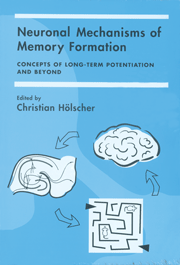Book contents
- Frontmatter
- Contents
- Contributors
- Introduction: Long-Term Potentiation as a Model for Memory Mechanisms: The Story So Far
- Section One Long-Term Potentiation In Vitro and In Vivo: How Can We Fine-Tune the Current Models for Memory Formation?
- Section Two There is More to the Picture Than Long-Term Potentiation: Theta or Gamma Oscillations in the Brain and the Facilitation of Synaptic Plasticity
- Section Three Making Models from Empirical Data of Synaptic Plasticity
- Section Four Setting the Stage for Memory Formation: Stress, Arousal, and Attention
- Section Five Transgenic Mice as Tools to Unravel the Mechanisms of Memory Formation
- 17 In Vivo Recording of Single Hippocampal Place Cells in Behaving Transgenic Mice
- 18 Understanding Synaptic Plasticity and Learning through Genetically Modified Animals
- 19 What Gene Activation Can Tell Us about Synoptic Plasticity and the Mechanisms Underlying the Encoding of the Memory Trace
- Conclusions and Future Targets
- Index
19 - What Gene Activation Can Tell Us about Synoptic Plasticity and the Mechanisms Underlying the Encoding of the Memory Trace
Published online by Cambridge University Press: 13 October 2009
- Frontmatter
- Contents
- Contributors
- Introduction: Long-Term Potentiation as a Model for Memory Mechanisms: The Story So Far
- Section One Long-Term Potentiation In Vitro and In Vivo: How Can We Fine-Tune the Current Models for Memory Formation?
- Section Two There is More to the Picture Than Long-Term Potentiation: Theta or Gamma Oscillations in the Brain and the Facilitation of Synaptic Plasticity
- Section Three Making Models from Empirical Data of Synaptic Plasticity
- Section Four Setting the Stage for Memory Formation: Stress, Arousal, and Attention
- Section Five Transgenic Mice as Tools to Unravel the Mechanisms of Memory Formation
- 17 In Vivo Recording of Single Hippocampal Place Cells in Behaving Transgenic Mice
- 18 Understanding Synaptic Plasticity and Learning through Genetically Modified Animals
- 19 What Gene Activation Can Tell Us about Synoptic Plasticity and the Mechanisms Underlying the Encoding of the Memory Trace
- Conclusions and Future Targets
- Index
Summary
SUMMARY
For almost a century we have been attempting to test the notion that information is stored in the brain as changes in the efficacy of synaptic connections on those neurons that are activated during learning. Since the discovery of long-term potentiation (LTP) in 1973, we have learned a great deal about the mechanisms underlying activity-dependent synaptic modification. To date, LTP is currently accepted as the most viable model of the type of modifications that would occur to process information and store the memory trace. Although over the past 25 years or so there has been a great deal of empirical data that allude to the possibility that this form of synaptic plasticity may well be one of the crucial mechanisms underlying learning and memory, we are still lacking definitive answers. We now know that LTP is the output of a series of biochemical and molecular events that in all likelihood results in a form of modification of neural networks. In this review we describe how the advances in molecular biology give us the tools to both investigate the mechanisms of synaptic plasticity and to apply these to investigations of the underlying mechanisms in learning and the formation of memories that have until now eluded us.
Introduction
One of the major concepts in our understanding of how memories are laid down in the brain lies in the notion that they (the memories) are encoded as spatiotemporal patterns of activity in cell networks, and not at the single cell level. An underlying principle is that the encoding and the storage of memory would therefore require some form of dynamic modification that is driven by the interaction between cells within these networks.
- Type
- Chapter
- Information
- Neuronal Mechanisms of Memory FormationConcepts of Long-term Potentiation and Beyond, pp. 450 - 475Publisher: Cambridge University PressPrint publication year: 2000



